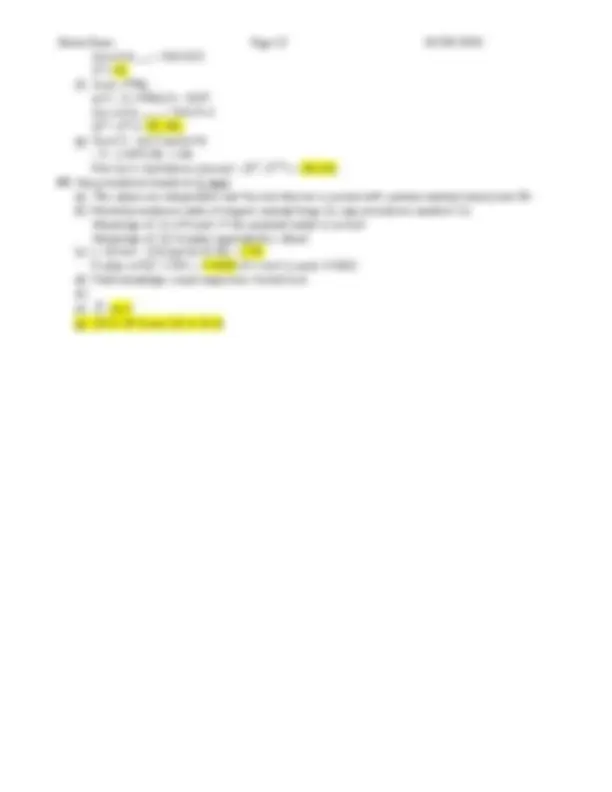



Study with the several resources on Docsity

Earn points by helping other students or get them with a premium plan


Prepare for your exams
Study with the several resources on Docsity

Earn points to download
Earn points by helping other students or get them with a premium plan
Community
Ask the community for help and clear up your study doubts
Discover the best universities in your country according to Docsity users
Free resources
Download our free guides on studying techniques, anxiety management strategies, and thesis advice from Docsity tutors
Solutions for a midterm exam in statistics, focusing on procedures based on signed ranks, signs, and z-test for analyzing head width measurements of mayfly species. It includes various tests, point estimates, and confidence intervals for the median head width, with assumptions and power of the tests discussed.
Typology: Exams
1 / 3

This page cannot be seen from the preview
Don't miss anything!


"1" 36 "2" 31 "3" 30 "4" 27 "5" 20
"6" 33 "7" 27 "8" 18 "9" 19 "10" 28 #1. (60 points) Use procedures based on signed ranks to answer the following questions. (a) What assumptions do you make about the distribution of the measurements when you employ these procedures? (b) Test the hypothesis that the median head width θ for mayflies from the habitat is 22 μm against alternative that it is greater than 22. Compute the P-value.
of θ.
the same confidence coefficient as in (e). Be sure to be conservative. #2. (60+10 points) Use procedures based on signs to answer the following questions. (Use all 10 numbers ) (a) What assumptions do you make about the distribution of the measurements if you employ these procedures? (b) Test the hypothesis that θ is 22 μm against alternative that it is greater than 22. (c) * What is the power of the test when the true θ is 25 μm? (d) Obtain a point estimate of the θ. (e) Find a lower confidence bound for θ with confidence coefficient .9453. (f) Obtain a confidence interval for θ with confidence coefficient .9786. (g) Use the large sample approximation to compute the confidence bound for θ with the same confidence coefficient as in (f). Be sure to be conservative. #3. (40+30 points) Use procedures based on Z-test (not t-test) to answer the following questions, assuming population standard deviation is know to be σ=6.12. (Use table A.1) Use the pre-computed sample
mean Z =26.95. (a) What assumptions do you make about the distribution of the measurements if you employ these procedures? (b) * Which of the three assumptions made so far (#1 (a), #2 (a), #3 (a)) is strongest? Which is weakest? What’re the advantages of using procedures based on weak assumptions? What’re the advantages of using ones based on strong assumptions? (c) * How would you decide which of the three procedures (#1, #2, #3) to use? (d) Test the hypothesis that θ is 22 μm against alternative that it is greater than 22. (e) * What’s the power of the test when the true θ is 25 μm? (f) Obtain a point estimate of θ. (g) Obtain two confidence intervals for θ with confidence coefficient .938 and. 9786, respectively.
#1. (7 points) Use procedures based on signed ranks to answer the following questions. Table for Wilcoxon signed rank test z R psi [1,] 14 14 10.0 1 10. [2,] 9 9 8.0 1 8. [3,] 8 8 7.0 1 7. [4,] 5 5 4.5 1 4. [5,] -2 2 1.0 0 0. [6,] 11 11 9.0 1 9. [7,] 5 5 4.5 1 4. [8,] -4 4 3.0 0 0. [9,] -3 3 2.0 0 0. [10,] 6 6 6.0 1 6.
Here are the Walsh averages: [,1] [,2] [,3] [,4] [,5] [1,] 14 11.5 11.0 9.5 6. [2,] NA 9.0 8.5 7.0 3. [3,] NA NA 8.0 6.5 3. [4,] NA NA NA 5.0 1. [5,] NA NA NA NA -2. Ordered Walsh averages: -2.0 1.5 3.0 3.5 5.0 6.0 6.5 7.0 8.0 8.5 9.0 9.5 11.0 11.5 14. Ordered Zs. 18.0 19.0 20.0 27.0 27.5 28.0 30.0 31.0 33.0 36.
(a) The values are independent and the distribution is continuous and symmetric around a common median. (b) T +^ =49. For n=10, P(T +>=49) = .014.
(d) (1-α)=.906. α=.094. tα = 13. Cα=n(n+1)/2 +1 - tα = 15+1-13 = 3. W (3)^ =3.0 (3.0, ∞) In terms of the original Z, it’s (25.0, ∞). (e) (1-α)=.938. α/2=.031. tα = 15. Cα=n(n+1)/2 +1 - tα = 15+1- 15= 1. (W (1)^ ,W(15)^ )=(-2.0, 14.0) In terms of the original Z, it’s (20, 36). (f) Cα = n(n+1)/4 - zα/2 sqrt(n(n+1)(2*n+1)/24) = = 7.5 – 1.866 * 3.7 = 0. Closest integer is 1. Answer is same as (e): (20, 36). #2. (7 points) Use procedures based on signs to answer the following questions. (a) The values are independent and the distribution continuous and has a common median (b) B=7. For n=10, P (^) 1/2 (B>=7)= 0. (c) B doesn’t change. (no # between 22 and 25). So the answer is 0.172, just as (b).
(e) (1-α)=.9453, α=.0547,